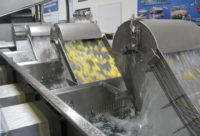FE interviewed Brian Flynn, chief technology officer of ZF Energy Development, to discuss the options processors have in cutting energy costs. ZF Energy Development investigates and restructures industrial energy portfolios to leverage generating assets, options, markets and capacities. The result is reduced energy rates, which vary from user to user, but can be as much as 10-20 percent.
FE: Many food and beverage processors have already picked “the low hanging fruit” (i.e., lighting, motors, air leaks, etc.) to cut energy usage and costs. Is demand control a good next step?
Brian Flynn: It is, up to a point. For example, demand control is often incompatible with capacity growth. We advise food processors to focus on productivity, i.e., energy content per standard unit shipped (dollars, standard hours, standard weight, etc.). In this way, planning for demand control does not conflict with production. On the other hand, installing VFDs and other demand regulators is really an efficiency-improvement exercise.
Other demand control methods such as demand-response (DR) contracts are fool’s gold, in my opinion. Companies pay for the grid capacity up front, and then a DR contract provides a small portion of that back. Our point is: Why pay the capacity charges to begin with?
FE: What lies beyond demand control to reduce a processor’s energy costs?
Flynn:Well, as I mentioned, getting out of the capacity charge game is one element. The other is to shorten the value chain.
FE: How can a smart grid, when it’s implemented in a certain area, help processors achieve better rates?
Flynn: I’m not sure about that, mainly because I don’t know what a smart grid is. Don’t get me wrong, I’ve designed a number of microgrids that exhibit adaptive behavior, but the smart grid in the mainstream press is looking more and more to me like talking household appliances. It’s nifty, but what exactly is the demand? I understand the supply—so local utilities can save money—but are these savings going to accrue to customers? The record leads me to believe this is not likely.
FE: Many processors have turned to bio-digesters to produce gas to heat boilers and power cogeneration systems. Do food processors want to be involved in the management of these systems?
Flynn: Any time you can create combustible fuel from bio-residue, it’s a good thing. While natural gas prices have really dampened the rate of new investment, existing installations continue to benefit by displacing purchases [of natural gas].
Now, you ask whether they should manage these systems, and history is replete with swings in management fashion on so-called “vertical integration.” But if you look at productive uses of capital, then onsite generation in general has to significantly outperform investment in one’s core business to justify self-capitalization. Some companies have a 25 percent IRR [internal rate of return] threshold for internal projects, which is really hard to do for energy projects. On the other side, in mature industries, an internal project might be considered good at 16 percent, and energy projects can offer 19 to 22 percent, so that’s attractive. But that may still be short-sighted, because the ostensible point of invested capital is to gain or maintain market share.
In other words, if you had $1 million to invest, should you invest in increasing market share of your core business or invest in an energy infrastructure? Right now, I would say nine out of 10 managers would choose increasing market share, unless they have oodles of cash lying around, as some actually do.

|
|
Brian Flynn, chief technology officer, ZF Energy Development.
As ZF Energy Development’s principal energy architect, Brian Flynn is the lead, hands-on engineer who designs, installs, implements and troubleshoots energy solutions that result in efficiency improvements and cost reduction. His areas of expertise include cogeneration, grid-load management, thermal stratification, lyophilization, waste-to-power, fluid dynamics and heat recovery. Flynn is a BSME graduate from Stevens Institute of Technology and a licensed professional engineer in nine states. |
FE: Does a processor that installs a cogen system capable of putting power back into the grid have more bargaining power over rates than those processors who don’t have the cogen capability?
Flynn: In order for me to answer this question, I have to examine the premise of the question. In deregulated markets, there’s nobody to bargain with. Utilities are basically trucking companies that are responsible for reliability and safety. And that’s a good and useful thing. But they don’t get to dictate my relationship with the energy marketplace.
The other part of your question about cogeneration is another issue. In current market conditions, cogeneration in and by itself offers marginal economics at best when deployed as baseload power. It’s highly unusual for a baseload cogeneration system—one that runs all the time—to yield greater than a 10 percent cost reduction, pre-capital. Once you account for the cost of money, there’s very little benefit left. Most cogeneration systems do not get off the ground in the US market because they just don’t pencil out.
And if you’re working with retail figures to justify baseload cogeneration, you might be better off just restructuring your buying process into the day-ahead market. Chances are you’ll come out ahead because an investment in risk hedging is likely to be less costly than infrastructure, permits and registrations.
So, to finally answer your question, if you’re asking whether baseload cogeneration gives food processors more bargaining power, I’d have to say, it does not because wholesale markets already offer power at prices cheaper than making it yourself.
FE: Some processors have built bio-digester/cogen systems that are pumping power back into the grid—with a lot of success. Others are moving toward “off-the-grid” operation. Either of these options can be expensive for small or mid-sized processors to implement. What are their options?
Flynn: Just because [some large processors] have afforded themselves expensive technology doesn’t mean that small to mid-sized processors have no options. Take one of our customers, Astra Foods, a small but rapidly growing processor in Philadelphia. It invested in our EPD system, and now it’s paying 30 percent less for energy. The IRR for Astra Foods was well over 25 percent, so it would have been crazy not to do it.
FE: Is it safe to assume that, with the additional natural gas inputs coming online, the cost of energy will increase more slowly—or remain steady—in the future?
Flynn: It seems like the EIA [US Energy Information Administration] agrees with you, and that volatility in electricity prices will not be created by natural gas price swings as in the past. But electricity is a value-added product, and retail delivery has a lot more cost inputs. For example, investments in infrastructure have nothing to do with fuel input. Also, costs incurred by investments in really big iron such as gigawatt class coal or nuclear power are sent by PUCs directly to rate payers. The CAGR of electricity prices since 1980 is at 2.7 percent per year, through thick or thin. I look at the landscape, and I see nothing that tells me this growth rate will go up or down.
FE: How does your group work with a processor to cut energy costs? How does your model work?
Flynn: We like to improve energy productivity in three steps:
1. Efficiency is always the biggest bang for the buck, and at this point, we assume most processors have done all they can. If not, we definitely put some efficiency programs in place.
2. We then look at energy supply logistics: We offer access to wholesale energy markets without the need for financial hedge instruments. In deregulated markets, we use real-time process control systems with our custom-designed generating assets [GAs] to import the overnight lows and cap the daytime highs. We call this our EPD [Economic Power Dispatcher] system, and it performs so well, we can capitalize it and still provide our customers a 20 percent cost reduction.
3. Finally, the use of generating assets sets in motion a number of additional efficiency-improvement options previously not available, such as thermal stratadesign. These techniques give our generating assets conversion efficiencies of as high as 90 percent, and double the energy productivity per earned value dollar.
The result of all this is a cost-reduction wallop up front with a plan for steady, annual improvements thereafter. And it doesn’t cost a dime.
FE: Is your group able to consult with a processor on natural gas and heating oil as well as electricity? If so, how can these numbers work together? Is there some synergy here?
Flynn: Absolutely. First, I have to say we’re not consultants; we’re an energy developer. In other words, we make our money off restructured energy supply chains.
We look at energy input per shipped dollar, so that’s all energy input paid. Most processors have switched to natural gas, of course, but there are quite a few major oil users out there that are beyond pipeline reach. So there we have to look at either investing in pipeline transport or an alternative fuel strategy. I don’t want to get ahead of myself here, but there are several available, given the price of heating oil.
Our generating assets deliver both electrical and thermal energy, whether steam, thermal oils, hot or chilled water or whatever. Part of our EPD system is a custom-designed thermal management infrastructure that delivers the exact temperatures and rates needed by our food processor customers.
FE: What might a processor expect on energy savings if it adopts your model? How would the model/savings/architecture vary according to energy markets?
Flynn: The more a customer pays for energy, the greater its savings. On the other hand, we are currently working on two projects where we can deliver 14 percent cost cuts without thermal utilization. Our model is best applied in deregulated markets.
FE: What up-front costs are involved in adopting your model/strategy?
Flynn: In short, none. Our model is so productive, we can capitalize it ourselves and still pass on benefits to our customers. But we have to restrict ourselves to customers with industrial-class volumes in excess of, say 10,000 MWh per year, across one or more locations.
For more information, contact Brian Flynn or visit www.z-fed.com.




